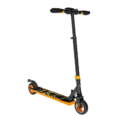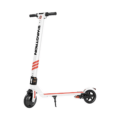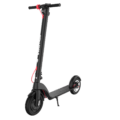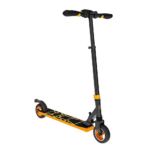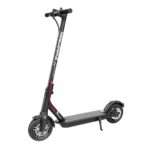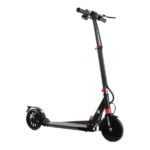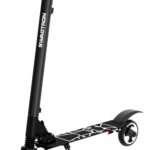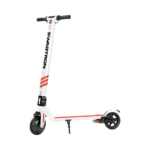- Home
- Scooters
- Electric Scooters
- Swagtron Swagger 7
Swagtron Swagger 7


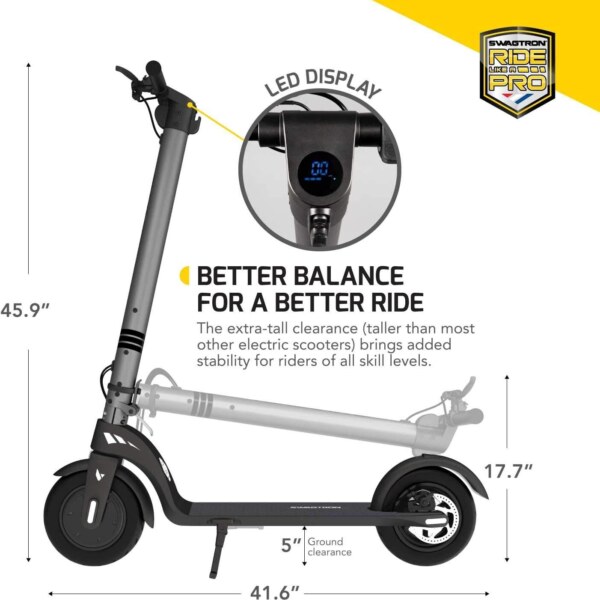
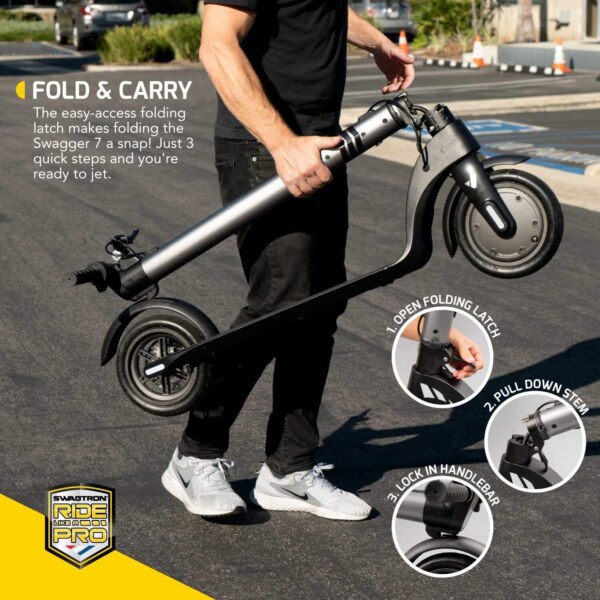
- Battery Range: 18.9–19.8 miles (30–32 km)
- Top Speed: 18 mph (29 km/h)
- Motor Power: 350 W
- Weight Capacity: 220 lb (100 kg)
- Charging Time: ~5–6 h
- Scooter Weight: 30.9 lb (14.0 kg)
PROS
- Removable 36 V battery option
- Longer range for class
- Multi-brake setup incl. disc
- 8.5″ pneumatic tires
- Foldable commuter frame
CONS
- Heavier than 5-series
- No official suspension
- App/ecosystem details sparse
- Region specs vary

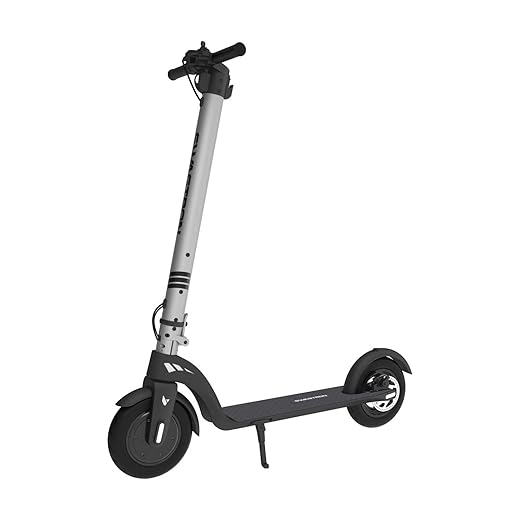
Key Takeaways
- The Swagtron Swagger 7 is a lightweight, folding electric scooter designed for short commutes and urban travel.
- It features an easy-to-use throttle, a removable battery, and safety lights, making it user-friendly for beginners.
- With a top speed of 15.5 mph, it handles flat and rolling routes but struggles on steep hills.
- This scooter excels in portability and storage, weighing just 27.55 lb, and can be easily carried or stowed away.
- Though great for casual riders, it isn’t ideal for those seeking high speeds or tackling long distances.
Table of contents
- What Is the Swagtron Swagger 7?
- How the Swagtron Swagger 7 Works
- Key Specifications
- Design & Build Quality
- Performance Fundamentals
- Battery, Range & Efficiency
- Ride Quality & Comfort
- Braking & Safety Features
- Portability & Daily Usability
- Maintenance & Care
- Weather & Seasonal Considerations
- Swagtron Swagger 7 vs Alternatives
- Who the Swagtron Swagger 7 Is (and Isn’t) For
The Swagtron Swagger 7 is a compact, folding commuter scooter built for simple daily rides. It suits riders who want low weight, easy controls, and dependable habits. The design favors predictability over flash, and that is the point. So it becomes a steady pick for short, routine trips.
What Is the Swagtron Swagger 7?
The Swagger 7 is a lightweight, front-hub-drive electric scooter with 8.5-inch air-filled tires. It folds along the stem for quick stowage, and the deck gives enough space for a natural stance. The top speed stays within typical city limits, and the brake lever cuts motor power as soon as you pull it. The battery sits in the stem and removes for charging or storage. You get a bright headlight, a taillight, a bell, and a simple LCD that shows speed and battery level.
So who is it for. Riders who want an easy, no-drama machine that handles short commutes and campus hops. The frame keeps weight low for stairs and bus transfers, and the controls make sense right away. Then the layout keeps working for daily riders who value a calm feel.
How the Swagtron Swagger 7 Works
Think of the Swagger 7 like a bicycle that hides a small helper in the front wheel. Press the thumb throttle, and the front hub motor pulls the scooter forward. Release the throttle, and the motor stops feeding power. Pull the brake lever, and a cut-off circuit ends power first, then the rear friction brake adds stopping force. The LCD shows speed and battery bars, and you can pick a speed mode to cap your pace. So new riders build confidence without feeling rushed.
Power flows from the battery down the stem to a controller tucked in the frame. The controller meters current to the motor like a dimmer switch. Push lightly on the throttle for a gentle start, and push farther for a stronger tug. For example, on level ground, a steady quarter-throttle gives a smooth cruise for bike-path speeds. Then a half-throttle push helps you clear a short rise without a surge.
Charging stays simple. Plug the 42-volt charger into the port on the stem, and watch the indicator change when the pack is full. Since the battery removes, you can carry it inside while you leave the scooter in a garage or storage room. That keeps your routine flexible on busy days.
Key Specifications
The table below summarizes the official specifications.
| Category | Details |
|---|---|
| General | Suitable rider height: 4’–6’6″ (120–200 cm). Weight capacity: 44–265 lb (20–120 kg). |
| Performance & Power | Max speed: 15.5 mph (25 km/h). Max climbing: 15° on short grades. Front hub motor. Speed-limit modes available on the display. |
| Battery, Charging & Electrical | Battery: 36 V, 6.4 Ah (removable). Charge time: 3–4 hours with 42 V, 2.0 A charger (model FY-4202000). Battery management: automatic shutoff, overcharge, under-voltage, and overheating protection. |
| Build & Dimensions | Unfolded: 41.57 × 16.5 × 45.66 in (1056 × 420 × 1160 mm). Folded: 41.57 × 16.5 × 17.7 in (1056 × 420 × 450 mm). Vehicle weight: 27.55 lb (12.5 kg). |
| Safety & Control | Brakes: electronic motor cut-off plus rear friction brake with “Autoguard.” IP rating: IPX4. Working temp: 32–109 °F (0–43 °C). Storage temp: −4–140 °F (−20–60 °C). |
| Features & Extras | 8.5-inch rubber, air-filled tires. Motorized front wheel, passive rear. LCD display. Bell. Kickstand. Headlight and taillight. Tire pressure: 50 PSI (3.4 bar). |
| Warranty & Compliance | 90-day limited hardware warranty. FCC compliance noted by the manufacturer. |
These specifications set the baseline for performance, care, and storage.
Design & Build Quality
Swagtron uses an aluminum alloy frame that balances strength and weight. The stem locks with a collar and latch that you can check by feel, and the deck wears a grippy surface that helps in light rain. The handlebar uses bolt-on grips and a centered LCD, and the throttle and bell sit within easy reach. The rear fender doubles as a friction brake. The headlight sits high on the stem for better throw, and the wiring stays tidy.
Fit and finish feel clean. Panels sit flush, and the charging door closes with a simple plug. The battery hatch in the stem twists and clicks into place, and the motion becomes second nature after a few days. For instance, after a charge, you seat the pack, press the cover, and twist to lock with a clear stop. The overall vibe is utilitarian, and that is good for serviceability. Parts look easy to replace, and the layout leaves room to work with a basic tool kit.
The folding joint keeps the stem secure at speed. You may feel slight flex if you bounce the bars, but that is common in this weight class. The joint hardware stays visible, so you can inspect it weekly. The deck length supports a front-to-rear stance for taller riders. And the 8.5-inch pneumatic tires add a layer of shock absorption that solid rubber cannot match.
Performance Fundamentals
On level ground the Swagger 7 moves off the line with a calm, linear pull. The front hub motor gives steady traction because it sits under your hands, and that helps new riders steer and modulate power at the same time. In Sport mode the scooter reaches its listed top speed of 15.5 mph (25 km/h), which fits shared paths and low-speed streets.
Acceleration feels predictable rather than punchy, and that makes pacing easy. So you can hold speed without micromanaging the throttle. For instance, on a flat bike path, a half-throttle input settles near mid-teens mph, and small bumps do not swing the pace.
Hill behavior depends on grade and rider weight, and that is normal. On modest grades near 7–10%, speed will fall as you climb, and then the motor finds a steady set point if you keep your posture relaxed and your weight centered. On short, steeper ramps the scooter slows more, and you may help with a kick or two to keep momentum. The 15° climb claim reflects peak capability on brief rises, not long sustained hills. So set proper expectations if you live in a hilly area.
Stability improves as the tires reach the correct pressure. At 50 PSI (3.4 bar), the contact patch stays firm, and that limits wobble at speed. The deck height supports a bent-knee stance that keeps your center of mass steady over the front axle. Then the scooter tracks straight even when a crosswind nudges the bars.
Battery, Range & Efficiency
The Swagger 7 runs a 36-volt, 6.4-amp-hour pack, which totals about 230 watt-hours. The pack sits inside the stem and removes for charging, and the official charge window is 3–4 hours with the 42-volt, 2-amp charger. In practice most top-offs after short hops take less time, and that helps when your day stays tight.
Rated range is 7.9 miles (12.75 km) under ideal conditions. That estimate assumes a rider near 165 lb (75 kg), smooth pavement, mild wind, and conservative speeds. Real life varies with rider mass, tire pressure, route, and temperature. For example, a 200 lb rider who cruises near full speed into a headwind will see fewer miles than a 150 lb rider who cruises at mid-teens mph on sheltered paths. So keep your tires at 50 PSI, avoid full-throttle starts, and ease off near the top of climbs. Then you stretch the pack without feeling slow.
Battery care matters for longevity. Charge soon after each ride, and store the pack at room temperature away from direct sun. If you plan to pause riding for more than a month, leave the pack near half charge and check it monthly. Since the battery removes, you can bring it indoors during winter, and that small habit pays off across seasons.
Ride Quality & Comfort
The 8.5-inch pneumatic tires provide the main suspension, and they soak up small cracks and joints that feel harsh on solid tires. At proper pressure the front tire rounds off the edge of a sidewalk seam, and the deck stays calm under your feet. The rear tire works with the deck to filter chatter, and the scooter feels planted on clean pavement.
The frame has a bit of stem flex on hard hits, which is normal for this class. Keep your elbows soft, and bend your knees slightly, and the ride smooths out. The bar width fits most adults, and the grips have enough texture for sweaty palms in summer. Then the cockpit keeps things simple on bumpy blocks.
Ergonomics are straightforward. The thumb throttle needs light pressure, and the brake lever has a short, firm pull that you can modulate with one finger. The deck height works well for riders in the listed range. The headlight improves visibility at dusk, and you can add a helmet light if you ride at night often. That extra height helps drivers see you from farther away.
Braking & Safety Features
The brake setup blends an electronic motor cut-off with a rear friction brake. Pull the lever, and the motor power ends first, which shortens stopping distance. Then the rear brake adds a direct, mechanical bite you can feel. In dry conditions the tire grips well, and in wet conditions you should use lighter inputs and plan ahead.
Lights matter for safety. The built-in headlight helps others see you, and the taillight marks your position from behind. Reflective tape on the deck or stem adds extra pop in car lights at night. The bell helps in crowded areas. The IPX4 rating covers splashes and light rain, not immersion or pressure washing, so keep that in mind before you hose it down.
Portability & Daily Usability
At 27.55 lb (12.5 kg), the Swagger 7 stays easy to carry for short stretches, and stairs are manageable with one hand on the stem and the deck against your leg. The folded size is about 41.6 × 16.5 × 17.7 inches, so it fits in a trunk, a closet, or under a desk. The latch closes with a clear hook, and that makes quick transfers painless.
Daily use stays simple. Keep a small pump plus a 4-mm and 5-mm hex key in your bag. Check tire pressure before longer rides, and wipe the deck and the stem after rain. Charge at work or at home as your schedule allows. Since the battery removes, you can lock the scooter in a bike room and take only the pack upstairs. That habit reduces theft risk and keeps charging indoors.
Storage is easy as well. The listed storage range runs from −4 °F to 140 °F, which covers most garages. Even so, avoid summer heat build-up in sealed cars, and bring the battery inside when temps swing outside the working band. Then keep the pack off cold concrete in winter to avoid condensation at the contacts.
Maintenance & Care
A light, regular routine keeps the Swagger 7 in shape.
Before each ride
- Check tire pressure. Target 50 PSI (3.4 bar).
- Squeeze the brake lever, and confirm a firm bite.
- Scan the stem latch and collar, and tighten if needed.
- Confirm lights and the bell work, and replace batteries in add-on lights as needed.
Every 2–4 weeks
- Inspect the rear friction pad for wear, and adjust cable slack at the lever if the bite feels long.
- Check bar-end bolts and the brake-lever clamp, and snug them carefully.
- Clean dirt from the charging port area, then close the rubber cap.
Every 2–3 months
- Remove the battery and inspect contacts for dust, and wipe with a dry, lint-free cloth.
- Look down the deck seam and the fender screws, and tighten to a snug feel.
- Inspect tires for cuts or embedded grit, and replace tubes at the first sign of repeat deflation.
Charging habits matter too. Use the included 42 V, 2 A charger on a stable surface, and keep airflow around the brick. Then unplug the charger from the wall before you unplug the scooter. That order reduces wear on the port and the plug.
Weather & Seasonal Considerations
The IPX4 rating means splash protection. It does not mean submersion or pressure wash. Light rain rides are fine if you slow down, brake early, and avoid puddles that hide holes. After a wet ride, towel the scooter dry and leave it open in a ventilated room. Then charge once the port area is fully dry.
Heat and cold both change range. In hot weather, store the scooter in shade, and avoid leaving the pack in a closed car. In cold weather, bring the battery indoors and start your ride with a warm pack. A cold pack sags in voltage faster and recovers once it warms. That behavior is normal for lithium-ion chemistry.
Tire pressure shifts with temperature, and small changes add up. A three PSI drop can dull steering and add rolling drag. A three PSI rise on a hot day can make the ride feel skittish. So adjust in small steps, then test on a safe, familiar path before you push speed.
Local rules vary by region, and some cities set speed or path limits for small electric vehicles. So learn your area’s rules, and match your speed to foot traffic.
Swagtron Swagger 7 vs Alternatives
The Swagger 7 sits in the light commuter class, and it trades peak speed and long range for low weight, simple care, and a friendly price point. Against larger commuter scooters, it wins on carry comfort, easy storage, and simplicity. It loses on top speed, long-hill pull, and braking hardware, since many heavier models add a rear disc or drum.
Compared with entry models that run solid tires, the Swagger 7 rides softer. The 8.5-inch pneumatic setup smooths rough pavement and grips better in the wet. Then again, air tires need checks and occasional tube swaps. If you want zero-maintenance rubber, you accept a firmer ride and less grip on slick paint.
You may also want to look at close cousins for context, and it helps to compare across tiers. For instance, some riders step up to the Swagtron 5 Elite for a different balance of features, and others prefer the compact feel of the Swagtron 5T for short hops. Those two give you a sense of how the brand scales features without jumping to heavy frames.
Off-road or performance scooters are a different class. They bring dual motors, suspension, and far more weight. They scale steep hills and hold higher speeds, and they ask for more space and care. So the Swagger 7 keeps its focus on the short, daily trip that favors a grab-and-go routine.
Where the Swagger 7 excels
- First electric scooter for adults and teens in the listed size range.
- Multi-modal commutes that mix walking, bus, train, and office.
- Short urban hops where storage and low weight matter most.
- Flat to rolling routes with brief rises rather than long climbs.
Where another class may fit better
- Very hilly towns with sustained 10% grades.
- Riders over the listed weight range.
- Long suburban routes that need higher speeds and bigger packs.
- Night-heavy riding that calls for brighter, taller lights and extra brake power.
Who the Swagtron Swagger 7 Is (and Isn’t) For
Great for
- Students who need a quick ride across campus, then a compact fold for class.
- Urban commuters who value a 27.55 lb (12.5 kg) carry and a simple latch.
- Apartment dwellers who want a removable battery for indoor charging.
- First-time riders who prefer a calm throttle and a capped top speed.
Not ideal for
- Riders who want 20+ mph (32+ km/h) cruising.
- Long daily routes over 10 miles (16 km) without a mid-day top-off.
- Heavy cargo use or very rough surfaces.
- Long, steep hills that demand higher continuous power.
Final Notes on Care and Safety
Keep the scooter clean and dry, and keep the tires at 50 PSI. Charge with the included 42 V, 2 A charger on a stable, ventilated surface. Then check the latch and brake feel each week. These small habits protect the scooter and make each ride safer.
Specifications
General
| Model The Model specifies the exact version or name of the scooter. It helps identify its unique design, features, and specifications within the manufacturer’s product line. Knowing the model makes it easier to compare options, find compatible accessories, or look up support information. | Swagger 7 |
| Brand The Brand identifies the manufacturer or company that designs and produces the scooter. A trusted brand is a sign of quality, reliability, and good customer support. Well-known brands often have higher standards for safety, performance, and after-sales service, giving you more confidence in your purchase. | Swagtron |
| Release Date The Release Date indicates when the scooter model was officially launched on the market. This helps you know how current the design, technology, and features are. A newer release date often means updated components, improved performance, and the latest safety or smart features. | 18 November 2025 |
| Recommended Age Recommended Age indicates the minimum age range that the scooter is designed for, based on safety, size, and ease of use. Following the recommended age helps ensure that riders can handle the scooter’s speed, weight, and controls comfortably and safely. Always check local laws and use protective gear, especially for younger riders. | +16 |
Performance & Power
| Motor Power (Wattage) What it means: The motor power, measured in watts (W), shows how strong the scooter’s electric motor is. Why it matters: Higher wattage usually means better acceleration, more torque, and improved performance on hills or rough terrain. For example, a 250W motor is good for flat city roads and light riders, while a 500W or 1000W motor provides more power for faster speeds or climbing steep inclines. | 350 W hub motor |
| Top Speed The Top Speed indicates the maximum speed that the scooter can reach under optimal conditions. It’s usually measured on level ground with a fully charged battery and an average rider weight. A higher top speed allows you to travel longer distances faster, but always ensure you ride within legal speed limits and your personal comfort zone for safety. | 18 mph (29 km/h) |
| Battery Capacity Battery Capacity refers to the total amount of energy the scooter’s battery can store, usually measured in ampere-hours (Ah) or watt-hours (Wh). A higher battery capacity means you can ride longer distances on a single charge, reducing the need for frequent recharging. Keep in mind that actual range can vary depending on rider weight, terrain, speed, and weather conditions. | 36 V 6.4–10 Ah (230–360 Wh) — varies by trim |
| Estimated Range per Charge The Estimated Range per Charge indicates the average distance the scooter can travel on a single full battery charge. This range is calculated under optimal conditions, such as flat terrain, moderate speed, and average rider weight. Real-world range may vary depending on riding style, terrain, weather, and load. A longer range means fewer recharges and greater freedom for longer trips. | 18.9–19.8 miles (30–32 km) |
| Hill Climb Ability Hill Climb Ability describes the maximum incline or slope that the scooter can handle while maintaining stable performance. It’s typically expressed as a percentage or in degrees. A higher hill climb rating means the scooter can tackle steeper hills without losing too much speed or power. Actual climbing performance may vary based on rider weight, battery charge, and terrain conditions. | Up to ~10° (manufacturer statements vary) |
| Drive System The Drive System refers to how power from the motor is delivered to the wheels. Electric scooters typically use either a hub motor (directly integrated into the wheel) or a chain/belt drive system. A high-quality drive system ensures smooth acceleration, efficient power transfer, and low maintenance. The choice of drive system affects performance, noise level, and overall ride experience. | Front hub (FWD) |
Charging & Electrical
| Charging Time Charging Time indicates how long it takes to fully recharge the scooter’s battery from empty to 100% using the standard charger provided. Faster charging means less downtime and more time on the road. Actual charging time may vary slightly depending on battery capacity, charger output, and environmental conditions. | Approx. 5–6 hours |
| Battery Type Battery Type refers to the specific technology used in the scooter’s battery, which affects performance, lifespan, weight, and charging time. Most modern electric scooters use high-quality lithium-ion (Li-ion) batteries because they offer a good balance of energy density, durability, and low maintenance. A reliable battery type ensures consistent power delivery and longer riding ranges. | Lithium-ion pack; removable on select trims |
| Removable Battery A Removable Battery means the battery pack can be easily detached from the scooter for convenient charging and replacement. This feature allows you to charge the battery separately, swap it with a spare for extended range, or securely store it indoors in extreme weather. Removable batteries add flexibility and make it easier to keep your scooter powered up wherever you are. | Removable battery (Yes, select trims) |
| Regenerative Braking Regenerative Braking is an energy-saving feature that converts some of the energy normally lost during braking back into battery power. When you slow down or brake, the motor works in reverse to generate electricity, which helps extend the scooter’s range and improves overall efficiency. This system also reduces wear on traditional brake components, leading to lower maintenance over time. | Yes (via electronic brake) |
| Lighting Lighting refers to the built-in front and rear lights that enhance visibility and safety when riding in low-light conditions or at night. Good lighting helps you see the road ahead and ensures that other road users can see you. Many scooters include LED headlights, taillights, and sometimes brake lights or side reflectors for added safety and compliance with local traffic regulations. | LED headlight + tail/brake + reflectors |
Build & Dimensions
| Scooter Weight Scooter Weight refers to the total weight of the scooter when fully assembled, including the battery. This affects how easy it is to carry, lift, and store the scooter when not in use. A lighter scooter is more portable and convenient for commuting, especially if you need to carry it upstairs or onto public transport. Keep in mind that a sturdy frame and quality components may add to the weight but also contribute to better durability and ride stability. | 30.9 lb (14.0 kg) |
| Maximum Rider Weight Maximum Rider Weight indicates the highest rider weight that the scooter is designed to safely support while maintaining optimal performance and stability. Staying within this limit helps ensure reliable acceleration, braking, and climbing ability, and it protects the frame, suspension, and motor from excessive strain. Exceeding the recommended limit may reduce performance and increase wear on components. | 220 lb (100 kg) |
| Deck Size Deck Size refers to the dimensions of the scooter’s standing platform. A wider and longer deck provides more foot space, allowing you to stand comfortably and adjust your stance while riding. A well-sized deck improves balance and stability, especially on longer rides or at higher speeds. Compact decks, on the other hand, help keep the scooter lightweight and portable. | Commuter geometry; detachable pack on Transport trim |
| Handlebar Height Handlebar Height refers to the distance from the deck to the handlebars, which affects your riding posture and comfort. An appropriate handlebar height helps you maintain good balance, reduces strain on your back and arms, and makes steering more comfortable. Some scooters have adjustable handlebars to fit riders of different heights, while others have a fixed height for a streamlined design. | Fixed |
| Folding Mechanism The Folding Mechanism describes how easily and securely the scooter can be folded for carrying and storage. A well-designed folding system lets you quickly collapse the scooter into a compact size, making it convenient to transport on public transit, store under a desk, or fit into a car trunk. Look for sturdy latches and safety locks to ensure the scooter stays firmly in place when folded or unfolded. | Folding stem latch |
| Dimensions Folded Dimensions indicate the size of the scooter when it’s fully folded. This measurement shows how much space the scooter will take up when stored or carried, making it easier to check if it will fit in your car trunk, under a desk, or in a closet. Compact folded dimensions are ideal for commuters who need to bring their scooter on public transport or store it in tight spaces. | Unfolded: 42.6 × 16.1 × 45.7 in (108.3 × 41.0 × 116.0 cm); Folded: 42.9 × 16.1 × 17.9 in (109.0 × 41.0 × 45.5 cm) |
| Material Material refers to the primary construction materials used for the scooter’s frame and key components. High-quality materials like aircraft-grade aluminum, reinforced steel, or durable composites provide strength, stability, and a lighter overall weight. A sturdy material ensures the scooter can handle daily wear and tear while maintaining safety and performance. | Aluminum alloy |
Safety & Control
| Brake Type(s) Brake Type(s) describe the braking systems the scooter uses to help you slow down or stop safely. Common brake types include mechanical brakes (like drum or disc brakes), electronic brakes, and foot brakes. Many scooters combine multiple braking systems for added safety and shorter stopping distances. The type and quality of brakes affect your control, especially when riding at higher speeds or on slopes. | Front electronic + rear disc + foot brake |
| Suspension Suspension refers to the system that absorbs shocks and vibrations while riding, providing a smoother and more comfortable ride over uneven or rough surfaces. Scooters may have front suspension, rear suspension, or dual suspension for better shock absorption and stability. Good suspension helps reduce rider fatigue and improves control, especially when riding on bumpy roads or off-road paths. | None |
| Tire Type Tire Type refers to the kind of tires the scooter uses, which directly affects ride comfort, traction, and maintenance. Common types include solid (airless) tires, pneumatic (air-filled) tires, or hybrid options. Pneumatic tires offer better shock absorption and a smoother ride on rough surfaces, while solid tires are puncture-proof and require less upkeep. The right tire type helps ensure safe handling and a comfortable ride in different conditions. | 8.5″ pneumatic street |
| Tire Size Tire Size indicates the diameter and width of the scooter’s tires, which affect ride comfort, stability, and how well the scooter handles different terrains. Larger tires generally offer better shock absorption and a smoother ride over bumps and rough surfaces, while smaller tires keep the scooter lighter and more portable. Choosing the right tire size helps ensure a balance between agility and comfort. | 8.5-inch |
| Kickstand The Kickstand is a built-in stand that allows you to park your scooter upright when it’s not in use. A sturdy kickstand keeps the scooter stable and prevents it from tipping over, protecting it from scratches and damage. It also makes storing and accessing your scooter more convenient, whether you’re at home, work, or on the go. | Side kickstand |
| Water Resistance Rating Water Resistance Rating indicates how well the scooter is protected against water and moisture, usually shown as an IP (Ingress Protection) rating. This rating helps you understand whether the scooter can handle light rain, splashes, or wet roads without damage. While most scooters are not fully waterproof, a good water resistance rating adds peace of mind when riding in changing weather conditions. Always avoid deep puddles or submerging the scooter to protect its electrical components. | IPX4 (varies by listing) |
Features & Extras
| Display/Console The Display (or Console) shows important real-time information about your ride, helping you monitor your scooter’s status at a glance. Typical displays show speed, battery level, distance traveled, and riding mode. Some models also include additional features like Bluetooth connectivity, app integration, or backlighting for better visibility at night. A clear and easy-to-read display enhances safety and convenience on every trip. | LED display with speed, battery, mode |
| Ride Modes Ride Modes refer to the different speed and power settings you can choose to match your riding style or road conditions. Common modes include eco for maximum range and energy efficiency, standard for everyday balance, and sport or turbo for higher speed and stronger acceleration. Switching between ride modes allows you to customize performance, conserve battery, and ride safely in various environments. | 3 modes (Eco/Standard/Sport) |
| Smart App Connectivity Smart App Connectivity lets you pair your scooter with a dedicated mobile app via Bluetooth. Using the app, you can monitor real-time ride stats like speed, battery level, and range, adjust settings such as ride modes or cruise control, lock the scooter for added security, and sometimes receive firmware updates. This feature adds convenience and allows you to personalize your riding experience right from your smartphone. | Bluetooth companion app (availability varies) |
| Anti-Theft System The Anti-Theft System helps protect your scooter from unauthorized use or theft. This feature can include built-in alarms, electronic motor locks, GPS tracking, or remote locking through a mobile app. A good anti-theft system provides peace of mind when parking your scooter in public spaces, adding an extra layer of security to safeguard your investment. | App lock (where app supported) |
| Cruise Control Cruise Control allows you to maintain a steady speed without continuously holding the throttle. This feature makes longer rides more comfortable by reducing hand fatigue and providing a smoother, more relaxed riding experience — especially on flat, open roads or bike lanes. For safety, cruise control can usually be easily activated or deactivated while riding. | Yes (cruise control) |
| Accessories Included Accessories Included lists the additional items that come with the scooter to enhance your riding experience and convenience. Common accessories may include a charger, kickstand, bell, lights, phone holder, or carrying strap. These extras add value by making your scooter safer, easier to use, and ready to ride straight out of the box. | Scooter, charger (42 V 2 A typical), tools, manual |
Warranty & Compliance
| Warranty Period The Warranty Period indicates how long the manufacturer guarantees the scooter against defects in materials and workmanship under normal use. A good warranty provides peace of mind, showing the brand’s confidence in its product quality. Always check what parts are covered, such as the frame, battery, and motor, and follow the maintenance guidelines to keep your warranty valid. | 12 months (region-dependent) |
| Certifications Certifications confirm that the scooter meets specific safety, quality, and environmental standards set by recognized organizations or regulatory bodies. Common certifications may include CE, RoHS, UL, or other local compliance marks, depending on your region. These certifications ensure that the scooter is manufactured to high standards and is safe and legal to use in your country. | Local micromobility regulations |
Price Comparison




